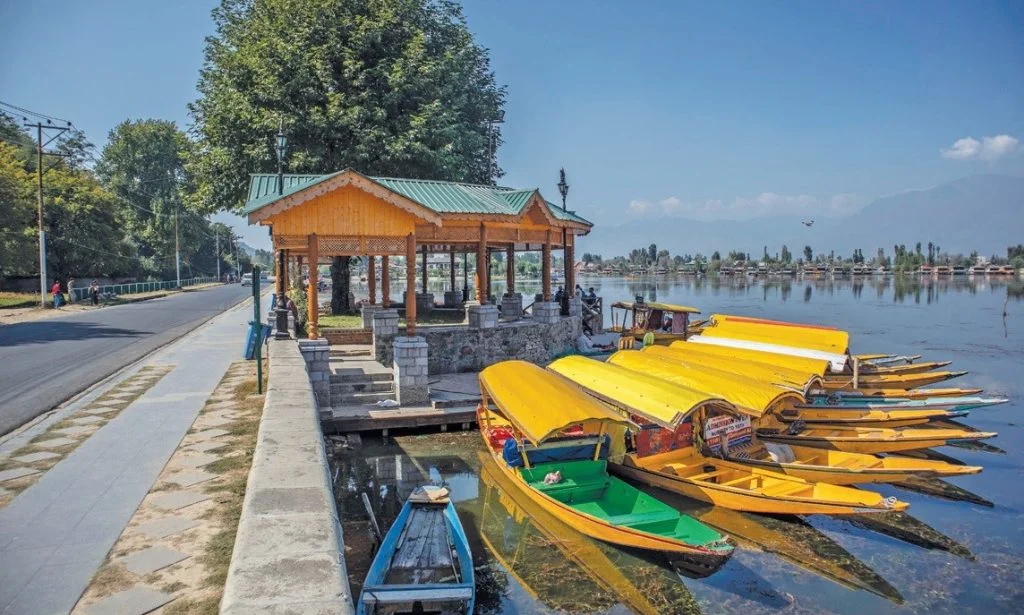The Struggles of Business Survival in Kashmir
By: Javid Amin | 12 September 2025
Survival, Not Growth
For months, the phrase “business in Kashmir will eventually recover” has echoed through conversations, statements, and press releases. Yet, on the ground, this hope feels painfully fragile.
For small shopkeepers in Srinagar’s Lal Chowk, for orchard owners in Shopian, for houseboat operators in Dal Lake, for fast-food outlets in Baramulla, and for handicraft artisans in Budgam, survival—not recovery—defines the present moment.
This tragedy is not merely economic. It cuts across dignity, morale, and identity. Businesses are more than financial ventures; they are family legacies, community pillars, and symbols of resilience. When shutters fall for months, it is not just balance sheets that collapse—it is the human spirit that suffers.
In this long-form feature, we examine sector by sector how Kashmir’s business landscape is struggling, what stories lie behind statistics, and how revival must be planned—not left to chance.
Kashmir’s Economy – Fragile by Design
Before diving into specific sectors, it’s important to understand why Kashmir’s economy is uniquely vulnerable.
-
Geographic Fragility
-
Landlocked, dependent on a single all-weather road: the Srinagar–Jammu National Highway.
-
Frequent landslides and blockades choke supply chains.
-
-
Conflict & Instability
-
Repeated lockdowns, shutdowns, and curfews.
-
Uncertainty scares away investors.
-
-
Sectoral Over-dependence
-
Heavy reliance on horticulture (especially apples), tourism, and handicrafts.
-
Weak diversification into manufacturing or IT.
-
-
Limited Institutional Support
-
Small businesses form the majority, often outside formal safety nets.
-
Bank loans, insurance, and relief rarely reach them in time.
-
This structural fragility means every crisis—natural, political, or economic—hits Kashmir harder than other regions.
Tourism Industry – Hotels, Houseboats & Hope on Hold
Tourism, often called the backbone of Kashmir’s economy, has been in freefall. Once drawing nearly 15–20 lakh visitors annually, the industry is now gasping for survival.
Hotels & Guesthouses
-
Occupancy rates have plummeted.
-
Many hotels have laid off staff, cutting jobs for cooks, cleaners, and receptionists.
-
EMIs on loans taken for hotel renovations are piling up without income.
Case Study:
Shahid, a hotel owner in Gulmarg, invested ₹1.2 crore to upgrade his property in 2021. Bookings in 2024 looked promising, but since May, cancellations skyrocketed. He says, “I now rent out rooms at half the rate just to keep the kitchen running.”
Houseboats on Dal & Nigeen Lakes
-
Houseboats, a cultural emblem, have been worst hit.
-
Without tourists, operators struggle to maintain wooden structures prone to decay.
-
Some have begun selling assets to survive.
Case Study:
The Wani family, houseboat operators for three generations, share: “This is not just business; this is our heritage. If we cannot maintain the boat, it dies with us.”
Travel Agents & Transporters
-
Tour operators report cancellations exceeding 70%.
-
Taxi drivers in Srinagar stand idle for days at TRC (Tourist Reception Center).
-
Shikara owners earn barely enough for fuel.
The Ripple Effect
When tourism collapses, restaurants, handicraft shops, guides, pony-wallas, and photographers all suffer. The ecosystem is so interdependent that losses cascade from top to bottom.
Horticulture – The Apple That Holds the Valley
Horticulture contributes nearly 8% to J&K’s GDP, employing around 3 million people. Apples alone are worth over ₹10,000 crore annually.
The Crisis
-
Trucks carrying apples stuck on the Srinagar–Jammu highway for weeks.
-
Perishable produce rotting before reaching markets.
-
Falling market prices due to delayed arrivals.
-
Rising competition from imported apples flooding Indian markets.
Case Study:
Manzoor Ahmed, an orchard owner from Shopian, says: “I lost nearly 40% of my crop this season due to highway delays. Cold storages are too costly, and buyers offer half the rate.”
Why It Hurts More
-
Apple farming is not just a business—it is a generational livelihood.
-
Families depend on one harvest for year-round expenses, marriages, education, and healthcare.
Food Industry – From Fast-Food to Frozen
The food sector in Kashmir, ranging from street-side kiosks to frozen food suppliers, is also bleeding.
Fast-Food & Cafés
-
Srinagar witnessed a café boom in recent years, run by young entrepreneurs.
-
Many have now shut down after months without customers.
-
Rentals in prime locations (Lal Chowk, Rajbagh) remain unpaid.
Frozen Food & Supply Chains
-
Frozen chicken and packaged food suppliers depend on regular cold transport.
-
With highway blockades, supplies rot or arrive late, losing quality.
-
Local bakeries report shortages of basic ingredients like flour, sugar, and butter.
Case Study:
A young entrepreneur who opened a burger outlet in Baramulla in 2023 says: “We were just building our brand. Now, without steady supplies and customers, I’m considering closing down.”
Traditional Kashmiri Food Vendors
-
Wazwan caterers face reduced bookings due to fewer weddings and economic distress.
-
Small dhabas along highways lose business when traffic halts.
Handicrafts – Heritage at Risk
Kashmiri handicrafts—pashmina shawls, carpets, papier-mâché, walnut woodwork—are world-renowned. Yet artisans are among the most invisible victims.
-
Export orders remain stuck due to logistical challenges.
-
Artisans face declining sales as tourists vanish.
-
Middlemen exploit desperate craftsmen by offering lower rates.
Case Study:
Parveena, a pashmina weaver in Budgam, says: “I used to sell two shawls a month. Now, no buyers come. My children ask why I work all day when it brings nothing.”
The risk is not just economic—it is cultural extinction. Centuries-old skills may vanish if the next generation sees no future in them.
Retail Trade & Small Businesses
From Lal Chowk to Sopore, retail shops remain half-shuttered.
-
Daily wage traders lose both stock and customers.
-
Rising transportation costs push up retail prices, discouraging buyers.
-
Clothing shops miss peak wedding season sales.
Case Study:
In Anantnag, a garment shop owner says: “I stocked clothes worth ₹8 lakh for Eid. By the time shops reopened, demand was gone. I am left with unsold stock and unpaid loans.”
Transport Sector – Wheels Without Movement
Transporters—truckers, bus operators, taxi unions—form another backbone of Kashmir’s economy.
-
With highways blocked, trucks remain stranded for weeks.
-
Local transport sees fewer passengers as people cut unnecessary travel.
-
Fuel shortages lead to higher fares, pushing commuters away.
Case Study:
Truck driver Ghulam Nabi stranded at Ramban says: “We sleep in our trucks, eat biscuits, and wait for the road to open. Every day is a loss, but we cannot abandon the cargo.”
The Struggles of Youth & Startups
In the last decade, Kashmir saw the rise of youth-led startups in IT, digital marketing, and e-commerce. But they too face hurdles:
-
Power cuts and internet disruptions halt operations.
-
Clients from outside Kashmir cancel projects citing reliability issues.
-
Investors hesitate to support Kashmir-based startups.
This threatens the digital future of Kashmir, pushing skilled youth into unemployment.
The Socioeconomic Toll
-
Unemployment rising: Already above 20%, one of the highest in India.
-
Debt traps: Families forced into loans at high interest rates.
-
Migration: Many youth consider moving out of Kashmir permanently.
-
Mental health crisis: Anxiety, depression, and hopelessness spreading widely.
The Policy Void – Questions Without Answers
Business leaders repeatedly ask:
-
Where is the economic relief package?
-
Why are bank loans and EMIs not restructured?
-
Why isn’t there a tourism revival strategy?
-
Why is horticulture not given transport subsidies?
The silence from governance is as damaging as the crisis itself.
Revival Roadmap – From Survival to Growth
Revival must be multi-pronged, sector-wise, and time-bound.
Tourism
-
Subsidies for hotels, houseboats, and travel agents.
-
Marketing Kashmir as a safe, year-round destination.
Horticulture
-
Subsidized cold storage facilities in every district.
-
Dedicated freight corridors for apples.
Food Industry
-
Localized cold chains for frozen food.
-
Tax relief for small eateries.
Handicrafts
-
Export facilitation centers.
-
Digital platforms connecting artisans directly to buyers.
Retail & Transport
-
Easy credit for small shops.
-
Fuel subsidies for stranded transporters.
Startups & Youth
-
Incubation hubs with reliable internet.
-
Grants for women-led businesses.
Faith, Resilience & Community Strength
At the heart of Kashmir’s survival lies resilience rooted in faith.
Prayer is not an escape—it is an anchor. Communities pool resources, neighbors share food, and families stand together. The Valley has endured crises before, and it will endure again—but this time, revival must be a collective pursuit.
“May Allah grant us patience to endure, clarity to organize, and hope to rebuild.”
Bottom-Line: A Future Still Possible
The struggles of Kashmir’s businesses reveal a painful truth: survival is never guaranteed, but neither is collapse permanent.
Every sector—tourism, horticulture, handicrafts, food, retail—tells the same story of loss, resilience, and cautious hope.
The path ahead requires policy clarity, investment, and unity. Kashmir does not ask for charity—it asks for opportunity, fairness, and recognition of its unique challenges.
Revival is not a promise written in speeches. It is a collective journey that must begin now.



